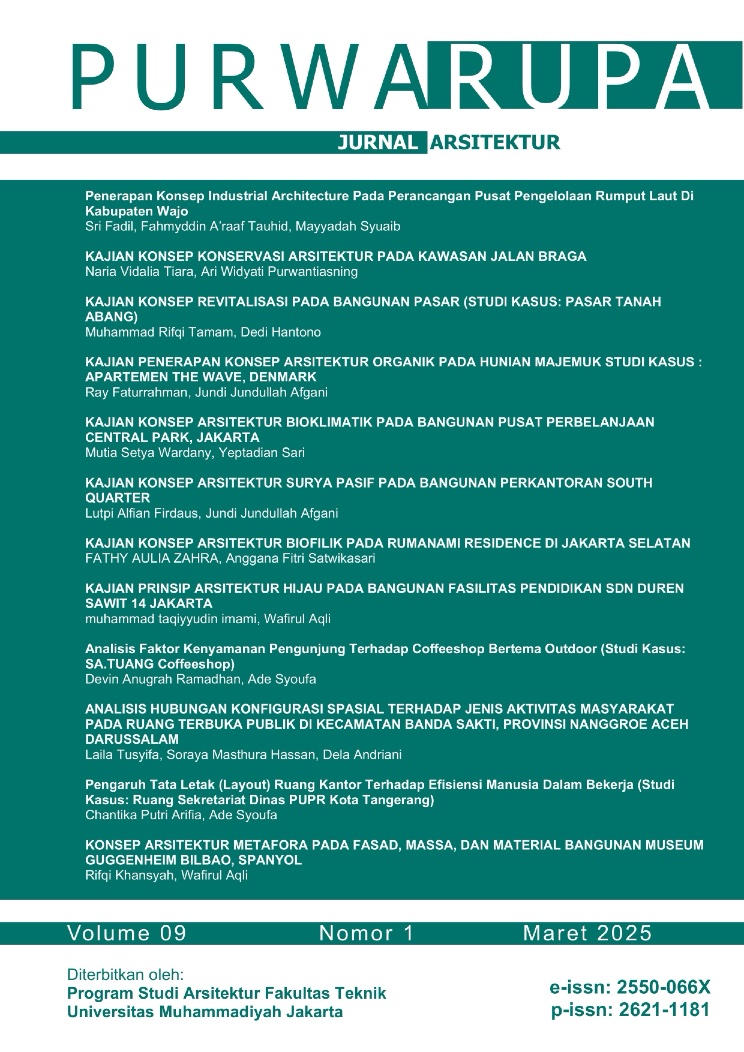KAJIAN KONSEP ARSITEKTUR SURYA PASIF PADA BANGUNAN PERKANTORAN SOUTH QUARTER
Abstract
ABSTRAK. Indonesia merupakan negara yang terletak digaris khatulistiwa sehingga memiliki iklim tropis. Wilayah negara yang memiliki iklim tropis akan mendapatkan sinar matahari sepanjang tahun dengan skala yang cukup intens. Sinar matahari yang terik dapat membuat hunian menjadi tidak nyaman untuk ditempati oleh penggunanya. Biasanya masalah ini disebabkan oleh kurangnya ventilasi alami dan juga pencahayaan yang masuk ke dalam bangunan sehingga penggunaan AC akan terus meningkat. Arsitektur Surya pasif mengacu pada bangunan modern yang mempertimbangkan masalah ini. Banyak penyesuaian yang dilakukan pada bangunan gaya lama untuk melindunginya dari berbagai iklim seperti hujan, terik matahari, dan angin. Arsitektur surya pasif dibentuk dengan menggabungkan penggunaan energi matahari dengan arsitektur terkini yang berorientasi pada matahari. Arsitektur surya pasif menggunakan energi matahari untuk memenuhi kebutuhan energi listrik yang efisien (lebih hemat energi) serta memiliki ruang sirkulasi udara yang cukup, dan merupakan tipe arsitektur yang mengedepankan penghematan energi. Tujuan penelitian ini adalah untuk mengetahui serta memahami penerapan prinsip arsitektur surya pasif dengan menganalisis bangunan perkantoran South Quarter sebagai objek penerapannya. Penelitian ini menggunakan metode deskriptif kualitatif, penulis mendeskripsikan dan mengidentifikasikan setiap aspek-aspek yang terdapat pada penelitian ini berdasarkan landasan teori yang diangkat sebagai panduan. Pada penelitian ini terdapat temuan bahwa bangunan South Quarter ini telah menerapkan dan memenuhi aspek-aspek yang terkandung di dalam konsep Arsitektur Surya Pasif. Kata Kunci: Arsitektur surya pasif, Bangunan Perkantoran, hemat energi, energi matahari ABSTRACT. Indonesia is a country located on the equator so it has a tropical climate. Areas of the country that have a tropical climate will receive sunlight all year round on a fairly intense scale. Hot sunlight can make a residence uncomfortable for its users to occupy. Usually this problem is caused by a lack of natural ventilation and lighting entering the building so that AC use will continue to increase. Passive Solar Architecture refers to modern buildings that take these issues into consideration. Many adjustments were made to old style buildings to protect them from various climates such as rain, hot sun and wind. Passive solar architecture is formed by combining the use of solar energy with the latest architecture that is oriented towards the sun. Passive solar architecture uses solar energy to meet electrical energy needs efficiently (more energy efficient) and has sufficient air circulation space, and is a type of architecture that prioritizes energy savings. The aim of this research is to find out and understand the application of the principles of passive solar architecture by analyzing the South Quarter office building as the object of its application. This research uses a qualitative descriptive method, the author describes and identifies each aspect contained in this research based on the theoretical basis which is adopted as guide. In this research, there are findings that the South Quarter building has implemented and fulfilled the aspects contained in the Passive Solar Architecture concept. Keywords: Passive solar architecture, Office Buildings, energy saving, solar energyReferences
(AEC), A. E. (2007). Passive Solar Handbook: Introduction to Passive Solar Concepts.
Dean, (2002). Meminimalkan penggunaan energi tanpa membatasi fungsi bangunan atau kenyamanan produktivitas penghuninya.
Detlev, G. (n.d.). The assessment of ten passive solar buildings in Tasmania.
Gunawan, W dan Anggana Fitri Satwikasari, (2021) Konsep Arsitektur Surya Pasif pada Bangunan Masjid Raja Haji Fisabilillah di Malaysia. Jurnal Linears
Holloway (2002). Desain Tenaga Surya Pasif digambarkan sebagai penggunaan bentuk dan bahan bangunan.
Jimmy Priatman, (2000) Perspektif Arsitektur Surya di Indonesia. DIMENSI (Jurnal Teknik Arsitektur).
Mimin. (2021) South Quarter.
Nikolić, D. dkk (2018) Basic Principles Of Passive Solar Heating. International Conference on Quality of Life
O’Connor, J. (1997). Tips for Daylighting With Windows.
Santoso dan Yasmin Suriansyah, N. (2019). Optimization Building Enclosure Redesign To Fulfill Natural Lighting Intensity Standard and Ottv in South Quarter Jakarta Office Building Based on Greenship Criteria.
Zhengtao, A. dkk (2022). International Energy Agency EBC Annex 80 - Resilient Cooling of Buildings.
Downloads
Published
How to Cite
Issue
Section
License
COPYRIGHT POLICY
The author(s) of an article published in the Jurnal Teknologi retains ownership of the intellectual property rights in work (s).
PUBLISHING RIGHTS
The author(s) of an article published in the Jurnal Teknologi have unrestricted publication rights. The authors give the Jurnal Teknologi the right to publish the article and designate the Faculty of Engineering Universitas Muhammadiyah Jakarta Publishing as the original publisher of the article.
LICENSING POLICY
Journal of Mechanical Engineering and Sciences is an open-access journal that follows the Creative Commons Non-Commercial 4.0 International License (CC BY-NC 4.0), which states that:

Under this license, the reusers must give appropriate credit, provide a link to the license, and indicate if changes were made. Users may do so in any reasonable manner, but not in any way that suggests the licensor endorses users or their use.
Please take the time to read the whole license agreement (https://creativecommons.org/licenses/by-nc/4.0/). As long as reusers follow the license conditions, the owner cannot withdraw these freedoms. The following components are included under this license:
 Attribution: Users must provide appropriate attribution, including a link to the license, and indicate whether or not they made any modifications. Users are free to do so reasonably, but not in a manner that indicates the licensee approves of their usage.
Attribution: Users must provide appropriate attribution, including a link to the license, and indicate whether or not they made any modifications. Users are free to do so reasonably, but not in a manner that indicates the licensee approves of their usage.
 NonCommercial: Users may not use the material for commercial purposes.
NonCommercial: Users may not use the material for commercial purposes.

